Effect of Different Thawing Methods on Quality Changes of Prepared Antarctic Krill Paste
-
摘要: 探究不同解冻方式(鼓气流水解冻、空气解冻、超声解冻、冷藏解冻及静水解冻)对南极磷虾滑品质的影响。本文通过分析保水特性、质构特性、蛋白氧化与脂质氧化等指标研究解冻方式对南极磷虾滑的影响。结果表明:鼓气流水解冻虾滑速度较快,但虾滑解冻损失率和蒸煮损失率较高,析水状态明显,保水性较差。冷藏解冻的虾滑相较于其他解冻方式其蛋白质氧化程度最低,具体表现为盐溶性蛋白含量最高(33.39 mg/g)和羰基含量最低(2.71 nmol/mg)。鼓气流水解冻和冷藏解冻的虾滑的挥发性盐基氮值(total volatile basic nitrogen,TVB-N)分别为11.36 mg/100 g和13.58 mg/100 g,显著低于空气解冻(16.57 mg/100 g)和静水解冻(15.40 mg/100 g)(P<0.05)。比较上述5种解冻方式的虾滑品质发现,经冷藏解冻的虾滑解冻损失率和蒸煮损失率最低,质构特性良好,且硫代巴比妥酸值(thiobarbituric acid value,TBARS)明显低于其他解冻方式,这表明其脂肪氧化程度较低。因此,冷藏解冻能延缓南极磷虾滑的蛋白质氧化和脂肪氧化,进而提高其保水性,减少汁液损失,是比较理想的解冻方式。Abstract: In this study, the effects of different thawing methods (blast water thawing, air thawing, ultrasonic thawing, refrigerated thawing and hydrostatic thawing) on the quality of Antarctic krill paste were investigated by analyzing the water retention properties, textural properties, protein oxidation, and lipid oxidation. The results indicated that krill paste thawed more rapidly in air-blasted flowing water. Nevertheless, the rate of thawing and cooking loss increased, which resulted in noticeable precipitation of water, and alleviated water retention ability. In contrast to other thawing methods, krill paste thawed by refrigeration exhibited minimal protein oxidation, which was confirmed by the highest salt-soluble protein content (33.39 mg/g) and the lowest carbonyl content (2.71 nmol/mg) . The total volatile basic nitrogen values (TVB-N) of krill paste thawed by blast water thawing and refrigerated thawing were 11.36 mg/100 g and 13.58 mg/100 g, respectively, which were significantly lower (P<0.05) when compared to air thawing (16.57 mg/100 g) and hydrostatic thawing (15.40 mg/100 g). The analysis of the krill paste quality resulting from five thawing methods revealed that krill paste thawed by refrigeration exhibited the lowest thawing loss and cooking loss, the most desirable textural characteristics, and a significantly reduced thiobarbituric acid values (TBARS) in comparison to the other thawing methods, indicating a lower degree of fat oxidation. Therefore, refrigeration during the thawing process can mitigate the oxidation of proteins and lipids in Antarctic krill paste, increasing water retention ability and decreasing thawing loss, making it a favored method for thawing krill paste.
-
Keywords:
- Antarctic krill /
- thawing methods /
- water retention properties /
- protein oxidation /
- lipid oxidation
-
南极磷虾(Euphausia superba)作为一种广泛生活在南大洋海域的浮游甲壳类动物[1],其总生物量约1.25~7.25亿吨。此外,南极磷虾营养价值高,是世界上最大动物蛋白来源。对于冷冻食品来说,无论是初加工或二次加工,都需进行解冻处理,使其恢复到冻结前状态,最大限度地还原食物本身的品质[2]。在水产品解冻过程中,不当的解冻方式会对水产品造成不可逆的影响。滑类制品是鱼、虾等水产原料经保水、斩拌、擂溃、调味和速冻处理后形成的具有一定弹性的糜类凝胶食品[3]。滑类制品的品质与其凝胶特性、质构特性和持水性相关;但在加工过程中,受多种物理因素和内源酶对蛋白的降解作用的影响,易导致产品出现凝胶强度降低、汁液流失等品质劣化问题[4]。由于南极磷虾肌原纤维蛋白质结构会发生改变,蛋白质易发生自溶,导致凝胶效果差,在宏观上表现为持水力、嫩度、色泽及质构特性等品质的下降[5];且解冻过程中的汁液流失会导致产品微生物滋生,营养物质降低,从而使产品的综合品质下降。
目前鼓气流水解冻、静水解冻、冷藏解冻等解冻方式已被广泛用于工业化生产和加工中。沈玉等[6]认为鸢乌贼冻结片经过静水解冻相比其他解冻方式,感官品质更高。翁梅芳等[7]认为与冷藏解冻等其他解冻方式相比,采用静水解冻或流水解冻可以较好地保证碎虾仁的品质。Chu等[8]认为与自然解冻相比,超声解冻使冷冻大黄鱼的品质更好,并且在240 W功率下效果最佳;对于水产品,在解冻过程中易发生蛋白质氧化和脂质氧化,这是影响品质特性的两个重要化学变化。有研究显示,在解冻过程中脂质氧化会产生相应的代谢产物,其可与蛋白质氧化产物发生交联,进一步加剧水产制品的氧化程度[9]。以虾滑为代表的糜类制品近年来受到广泛关注,但不同解冻方式对滑类制品的蛋白氧化、脂肪氧化及其对品质的影响鲜有报道。
本实验采用鼓气流水解冻、空气解冻、超声解冻、冷藏解冻和静水解冻5种方式对南极磷虾滑进行解冻,研究了在不同解冻方式下虾滑的保水性(解冻损失率、蒸煮损失率和持水力)、质构特性、可溶性蛋白含量、羰基含量、硫代巴比妥酸值(thiobarbituric acid value,TBARS)和挥发性盐基氮值(total volatile basic nitrogen,TVB-N)等指标,并进一步通过相关性分析探究蛋白氧化及脂肪氧化与虾滑品质的潜在关系,研究结果将为南极磷虾滑的贮藏及深加工奠定理论基础。
1. 材料与方法
1.1 材料与仪器
南极磷虾 大连辽渔远洋食品有限公司;南美白对虾 大连市仟和市场;食盐 中盐国本盐业有限公司;羟丙基木薯淀粉 苏州高峰淀粉科技有限公司;1.0%鲟鱼皮胶原蛋白肽 陕西萤草生物科技有限公司;氧化镁、乙酸乙酯 天津市科密欧试剂化学试剂有限公司;三氯乙酸 国药基团化学试剂有限公司;无水乙醇 天津市富宇精细化工有限公司。
JR-06型绞肉机 德玛仕智能厨房设备有限公司;BCD-568WDPF普通冰箱 海尔集团;GSP-6温湿度记录仪 江苏省精创电气股份有限公司;9FT1000鼓气水浴锅 上海宗网厨房设备有限公司;TA.XT.plus质构仪 英国 SMS 公司;TOMY CAX-571离心机 池田屋实业(深圳)有限公司;M200酶标定量测试仪 瑞士Tecan Infinite公司;K9840自动凯氏定氮仪 海能仪器股份有限公司。
1.2 实验方法
1.2.1 南极磷虾滑样品的制备
根据前期实验[10],将冷冻南极磷虾在4 ℃条件下对其进行解冻,南极磷虾用0~4 ℃的冷却水漂洗2次后沥干水分并控制水分质量分数在80%左右。将沥干水分的南极磷虾投入到绞肉机中斩拌2 min得到南极磷虾糜。南极磷虾糜按一定比例与其他虾糜混合进行擂溃1 min,加入3.7%鸡蛋清及盐等调味料混合5 min,随后加入羟丙基木薯淀粉等增稠剂搅拌4 min,最后加入保水剂得到南极磷虾滑样品。整个斩拌过程控制温度低于4 ℃。将制得样品以150±1 g一组用真空袋密封,置于−20 ℃冰箱中贮藏90 d。
1.2.2 解冻方法
将冷冻虾滑从−20 ℃冰箱取出,按表1的五种解冻方法,解冻终点为0 ℃。记录解冻时间并进行指标测定。
表 1 南极磷虾滑解冻方式Table 1. Antarctic krill paste thawing methods解冻方式 操作方法 鼓气流水解冻 将袋装虾滑置于鼓气流水解冻装置的槽中,水温为(20±1)℃,待虾滑中心温度达到0 ℃为解冻终点 空气解冻 将袋装虾滑置于周围无热源的瓷盘上,以(20±1)℃空气为介质进行解冻,待虾滑中心温度达到0 ℃为解冻终点 超声解冻 将袋装虾滑浸泡于装有(20±1)℃水(通过加入冰块保持温度)的超声清洗器中解冻,输入功率200 W,频率40 kHz,待虾滑中心温度达到0 ℃为解冻终点 冷藏解冻 将袋装虾滑置于(4±1)℃冰箱中解冻,待虾滑中心温度达到0 ℃为解冻终点 静水解冻 将袋装虾滑浸没在1000 mL的水中,初始水温为20 ℃,控制水温(20±1)℃(通过加入冰块保持温度),待虾滑中心温度达到0 ℃为解冻终点 1.2.3 南极磷虾滑热诱导凝胶的制备
将解冻后的虾糜填充至柱状透明PC管(长×宽×高=25 mm×25 mm×30 mm),并用保鲜膜封紧,参考杨姣等[11]的方法采用二段式加热的方法,于40 ℃加热60 min,90 ℃加热30 min后,置于冰水冷却20 min,4 ℃冰箱过夜储藏备用。
1.2.4 解冻曲线测定
在南极磷虾滑样品的中心位置插入温度记录仪的探头,并实时监控中心温度的变化,当样品中心温度达到0 ℃时,作为测定的结束点。
1.2.5 全质构测定
根据姚志琴[12]的方法并加以改进。将南极磷虾虾糜凝胶取出,将凝胶分成30 mm高的圆柱体,放置于室温30 min,用TA.XT.plus质构仪的P/50探头进行测定。测前速度为2.00 mm/s,测中速度为1.00 mm/s,测后速度为5.00 mm/s,连续两次下压,压缩比为30%,停留间隔时间5 s,负重探头类型为Auto-5 g,测定温度为室温,每组样品平行测定6次。
1.2.6 解冻损失率测定
根据罗翌元等[13]的方法并加以改进,将解冻前虾糜进行称重(m1),取出冻藏虾糜于4 ℃冰箱中解冻3 h后,用吸水纸吸干表面水分后再进行称重(m2)。解冻损失率按式(1)计算。
(1) 1.2.7 蒸煮损失率测定
根据程成鹏等[14]的方法并加以改进,称取一定质量(m0)的虾糜于蒸煮袋中,将其放在90 ℃恒温水浴锅中进行加热30 min后并冷却至室温,吸干水分后称量(m1)。蒸煮损失率按式(2)计算。
(2) 1.2.8 持水力测定
根据Jiang等[15]的方法并加以改进,将从冰箱取出室温放置平衡1 h后的虾糜凝胶切成重2~2.1 g左右的厚片,每个厚片称重记为W1,用3层滤纸包裹放入50 mL离心管中,用冷冻离心机在4 ℃条件下,4000 r/min离心20 min。样品离心后迅速精准称重为W2,结果为3次测定平均值。样品的持水力按照公式(3)进行计算。
(3) 式中:WHC为持水力,%;W1为离心前虾糜凝胶样品质量,g;W2为离心后虾糜凝胶样品质量,g;
1.2.9 TVB-N值测定
精确称取10 g虾糜,加入100 mL去离子水进行均质,浸渍30 min后过滤,取10 mL滤液于消化管中,加入1 g氧化镁后立刻将消化管放入凯氏定氮仪上,蒸馏4 min,用20 g/L硼酸溶液吸收,然后用标准盐酸溶液进行滴定,计算方法见式(4)。
(4) 式中:X为样品中挥发性盐基氮的含量,mg/100 g;c为盐酸标准溶液的实际浓度,mol/L;V1为测定试样所消耗盐酸标准滴定溶液体积,mL;V2为空白所消耗盐酸标准滴定溶液体积,mL;V为准确吸取的滤液体积,mL;V0为样液总体积,mL;m为称取样品质量,g;100为计算结果换算为mg/100 g的换算系数。
1.2.10 TBARS值测定
样品的硫代巴比妥酸值参考John等[16]的方法,准确称取2 g解冻后的虾糜于50 mL离心管中,加入10 mL硫代巴比妥酸溶液(0.375% 2-硫代巴比妥酸,15%三氯乙酸(trichloroacetic acid,TCA),0.25 mol/L盐酸溶液),在10000 r/min匀浆1 min,静置30 min后沸水浴20 min,取出后冰水冷却至室温,在4 ℃、7510×g条件下离心10 min,在532 nm处测定上清液的吸光度值。
1.2.11 可溶性蛋白质含量测定
称取约2.0 g研碎的虾糜,加入20 mL磷酸盐缓冲液(0.1 mol/L NaCl,2 mmol/L KCl,pH7.0),在10000 r/min下匀浆1 min。将匀浆的样品通过冷冻离心机在4 ℃、8000×g下离心10 min,重复两次。取上清液使用双缩脲法测定水溶性蛋白含量。向沉淀物中加入20 mL磷酸盐缓冲液(0.6 mol/L NaCl,pH7.0),在10000 r/min下均质1 min,4 ℃提取24 h,然后在4 ℃、8000×g下离心10 min。收集上清液即为盐溶性蛋白质。采用ELIASA软件在540 nm处进行蛋白质含量分析。
1.2.12 羰基含量测定
参考Lin等[17]的方法并稍作修改。将盐溶性蛋白溶液(1 mL,2 mg/mL)与1 mL 10 mmol/L的2,4-二硝基苯肼(2,4-dinitrophenylhydrazine,DNPH)混合。阴暗处反应1 h,反应期间每10 min振荡一次,再加入1 mL 20%三氯乙酸溶液,以8000×g将该混合液离心10 min,用乙醇/乙酸乙酯溶液洗涤沉淀3次,沉淀中加入盐酸胍溶液(3 mL,6 mol/L)在37 ℃下孵育15 min,8000×g离心10 min,收集上清液。在370 nm测定上清液吸光度。
1.2.13 感官评价
根据朱凯[18]的方法并稍作修改。用瓷勺将虾滑制成直径为3 cm左右的球状,将其在沸水中煮制3 min后捞出。由接受过感官检验训练的研究生男女各5人组成评价小组,每位成员依次品尝不同处理组的虾滑样品,以表2所考察指标进行感官评价,评价经不同解冻方式解冻后南极磷虾滑生制样品的组织状态,同时观察南极磷虾滑的特征。结果为去掉最高和最低评分后取平均值。
表 2 南极磷虾虾滑感官评分标准Table 2. Sensory evaluation criteria of Antarctic krill paste指标 感官评分标准 评分(分) 生制样品组织状态
(20分)组织坚实,无析水现象,挤出时呈连续流动状 14~20 组织略有分散,略有析水现象,挤出时基本呈连续流动状 7~13 组织分散、析水现象明显,挤出时有明显断裂现象 0~6 熟制样品弹性
(20分)弹性好,成型规则,按压无散开,可恢复原状 14~20 弹性一般,基本成型,按压无散开,松手恢复原状稍慢 7~13 基本无弹性,无法成型,按压立即散开 0~6 熟制样品口感
(20分)口感细腻嫩滑,硬度适中,有嚼劲 14~20 口感细腻、嫩滑感差,质地偏硬,稍有嚼劲 7~13 口感粗糙,质地偏软,无嚼劲 0~6 熟制样品风味
(20分)有浓郁磷虾肉鲜味,咀嚼后有甜味和鲜味突出 14~20 磷虾肉鲜味适中,咀嚼有甜味和鲜味但味道较淡 7~13 几乎虾肉鲜味,甜味和鲜味淡 0~6 整体接受度
(20分)接受度高 14~20 接受度一般 7~13 难以接受 0~6 1.3 数据处理
所有实验平行测定3次,结果为均值±标准差。实验数据采用 IBM SPSS 26.0 统计软件进行方差和显著性分析(邓肯检验),显著性水平P<0.05,使用Origin 2021软件进行图表绘制。采用 Pearson 检验分析各指标之间的相关性。
2. 结果与分析
2.1 南极磷虾滑在解冻过程中温度的变化
5种解冻方式下虾滑的中心温度变化如图1所示,在不同解冻方式下,样品的中心温度达到0 ℃的时间不同,由快到慢顺序依次是鼓气流水解冻、超声解冻、静水解冻、空气解冻、冷藏解冻;分别需要18、24、36、96、177 min。表明鼓气流水解冻可大幅度地减少虾滑的解冻时间。这是由于“鼓气”可促进物料和水之间的热交换,带走解冻桶中的冷量[19],促进虾滑的解冻,提高了解冻效率。超声解冻虾滑所需的时间仅次于鼓气流水解冻,这是由于超声解冻可以将超声波作用于水产生空化气泡,提高传热效率,从而缩短解冻时间[20]。而静水解冻是依靠解冻介质水和虾滑之间的热传导解冻,由于热传导的热交换率高于对流的热交换率[21],因此静水解冻比冷藏和空气解冻耗时短。冷藏和空气解冻耗时长,因为这两种解冻方式是通过自然对流解冻,热交换率低,因此解冻速率较低。
2.2 解冻方式对南极磷虾滑质构特性的影响
冷冻水产品在解冻的过程中,肌肉的硬度、弹性和咀嚼性等质构特性的差异与肌肉蛋白质的变性程度密切相关[22]。不同解冻方式对虾滑质构特性的影响见表3。解冻方式对虾滑的粘聚性和回复性无明显影响。冷藏解冻明显提高了虾滑凝胶的硬度、弹性和咀嚼性,在虾滑的质构特性方面有很好的保护作用,这可能是因为冷藏解冻采用自然空气对流进行解冻,降低了虾滑中心与表面的温差,维持了细胞间的结合力,使其汁液流失情况少,从而较好地保护了虾滑的质构[7,23],这与王凤玉等[24]研究的低温空气解冻下的秋刀鱼硬度最大的结果一致。空气解冻后的虾滑硬度、咀嚼性和弹性最低,原因可能是该解冻方式使虾滑暴露在空气中,导致其蛋白变性程度相对于其他解冻方式较高,从而使虾滑的质构特性降低。而鼓气流水、超声与静水解冻的虾滑硬度和弹性等指标三者间无显著性变化(P>0.05)。
表 3 不同解冻方式对南极磷虾滑质构特性的影响Table 3. Effects of different thawing methods on the textural properties of Antarctic krill paste解冻方式 硬度(g) 弹性 粘聚性 咀嚼性 回复性 鼓气流水解冻 607.52±8.49ab 0.73±0.01ab 0.39±0.01a 171.64±9.15ab 0.16±0.01a 空气解冻 493.43±38.11c 0.70±0.02b 0.38±0.01a 149.88±17.72b 0.15±0.01b 超声解冻 567.48±15.98b 0.73±0.01ab 0.40±0.02a 164.01±13.30ab 0.16±0.01ab 冷藏解冻 629.21±11.81a 0.75±0.01a 0.41±0.01a 184.13±16.98a 0.17±0.01a 静水解冻 561.80±1.51b 0.73±0.03ab 0.39±0.02a 178.13±4.94a 0.16±0.01ab 注:同列不同小写字母表示不同解冻方式间差异显著(P<0.05)。 2.3 解冻方式对南极磷虾滑保水性的影响
5种解冻方式对南极磷虾保水性的影响如图2所示,主要通过解冻损失、蒸煮损失和持水力表示[25]。从图2A可知,冷藏解冻损失率最小,为2.14%,鼓气流水解冻的损失显著高于其他处理组(P<0.05),为4.91%;冷藏解冻虽解冻时间较长,但其解冻的温度较低,解冻过程较温和,对虾滑肌肉组织损伤小,减少了水溶性蛋白等物质的流失,有利于肌肉组织对融化水的重吸收[26]。而鼓气流水解冻相较于其他组别解冻速率快,解冻时细胞体积会发生快速变化产生内应力,从而使细胞更容易被破坏[27]。因此,鼓气流水解冻虽然缩短了解冻时间,但是“鼓气”的气泡与水流动的效果叠加作用也使细胞内的水分子发生剧烈的物理运动,增大了内应力,促进物料和水之间的热交换,导致大量的汁液流失。
不同解冻方式对虾滑的蒸煮损失率(图2B)和持水力(图2C)均有不同程度的影响。其中冷藏解冻后虾滑蒸煮损失率最低,持水力最高,更好地维持了虾滑的保水性;鼓气流水解冻与空气解冻后的虾滑蒸煮损失率较高,而持水力低于其他3种解冻方式,这可能是由于鼓气流水解冻虽可以在短期内实现虾滑的解冻,更快速地通过最大的冰晶溶解带,从而降低了微生物繁殖的时间,但气泡与水的叠加作用可能使虾滑蛋白质网络结构被破坏,导致蒸煮损失率增加、持水力下降;而空气解冻时间长,为微生物滋生提供了更多机会,导致蛋白质被分解,无法有效与解冻后被吸收的水分进行水合作用[27]。超声解冻及静水解冻两者之间蒸煮损失率及持水力差异不显著(P>0.05)。
2.4 解冻方式对南极磷虾滑TVB-N值的影响
TVB-N值是衡量水产品新鲜度的一个重要指标。我国对海水虾类TVB-N值限定要求为30 mg/100 g,从图3中可以看出经过5种解冻方式处理后,虾滑的TVB-N值均在限定范围内。其中鼓气流水解冻的TVB-N值最小(11.36 mg/100 g),这可能是因为鼓气流水解冻速度快、时间短,微生物和内源性酶(钙蛋白酶、组胺脱羧酶)对其蛋白质的分解少,产生的氨以及胺类等碱性含氮物质少[28],这与刘欢等[19]的研究结果一致。空气解冻与冷藏解冻相比虽具有较快的解冻速率,但冷藏解冻是处于4 ℃的低温,环境条件温和,抑制了微生物和内源性酶的作用;而前者所处的解冻环境温度较高,更有利于酶的作用和微生物的活动,对虾滑的蛋白质分解程度较高,因此表现为更高的TVB-N含量(16.57 mg/100 g)。
2.5 解冻方式对南极磷虾滑TBARS值的影响
TBARS值表示脂质氧化的程度,主要用来表征丙二醛的含量;一般来说,TBARS值越大则表明冷冻产品的氧化程度越高[29]。在冷冻贮藏的过程中,虽然虾糜中大多数水分都已生成冰晶,但由于溶质浓缩等作用,部分氧化反应仍在进行[30]。虾糜表面的冰晶在冷冻过程中容易升华形成孔洞,而一些外源因素,例如加工或储存过程中混入的空气和金属离子会与脂肪接触,从而促进自由基的生成,进一步加速脂质的氧化过程。另外,虾滑中存在的抗氧化酶在经历冷冻与解冻的过程中会发生变性,进一步加速了脂肪的氧化过程[31]。由图4可知,在虾滑解冻过程中,不同的解冻方法对其TBARS有显著影响。冷藏解冻的虾滑其TBARS值(0.83 mg/100 g)显著低于空气解冻和静水解冻(P<0.05),表明其在低温解冻环境下虾滑的脂肪氧化程度最低。鼓气流水解冻与超声解冻组的TBARS值仅次于静水解冻但差异不显著(P>0.05),脂肪氧化程度均较低,可能是由于流动的水及超声波产生的空化效应会加速冰晶的融解,迅速通过−5~0 ℃这一生化反应最剧烈的过程[27,32]。此外,水里面的氧气含量低,也会导致脂质氧化较慢[29];而空气解冻的TBARS值(1.03 mg/100 g)显著高于其他解冻方式(P<0.05),可能是因为空气解冻长时间暴露在空气中与氧气接触加速了脂肪的氧化。
2.6 解冻方式对南极磷虾滑可溶性蛋白含量的影响
不同的解冻方式对虾滑水溶性蛋白含量和盐溶性蛋白含量均有一定的影响。从图5可知鼓气流水解冻的虾滑其水溶性蛋白含量(79.06 mg/g)最低。而冷藏解冻水溶性蛋白含量和盐溶性蛋白含量显著高于其他组别(P<0.05),原因可能是虾滑的外部温度处在较低水平,细胞内外形成较小的浓度差,能够减弱蛋白质的过度聚集交联程度,减缓了肌原纤维蛋白的降解[25,33]。静水解冻相较于其他组别盐溶性蛋白含量较高,与冷藏解冻组间无显著性差异(P>0.05)。可能是由于水中的含氧量低,使蛋白的氧化程度低,对虾滑蛋白的损伤程度小[29]。空气解冻组的盐溶蛋白含量显著低于其他组别(P<0.05),与鼓气流水解冻差异不显著(P>0.05),原因可能是解冻时间较长,脂肪发生氧化生成过氧化物并与蛋白质反应形成复合体,促进蛋白质的聚合交联[19,34],从而造成盐溶性蛋白含量的降低。
2.7 解冻方式对南极磷虾滑羰基含量的影响
蛋白质羰基化是衡量蛋白质是否发生氧化的一个重要指标。蛋白氧化会使包裹在蛋白质分子内部的氨基酸暴露,使羰基化合物的生成量增多[35]。解冻方式对虾滑羰基含量的影响如图6所示。冷藏解冻后羰基含量为2.71 nmol/mg,显著低于其他组别(P<0.05),是因为在解冻过程中一直处于低温状态,因此降低了蛋白质结构的氧化。姜晴晴等[36]研究发现,带鱼经冷藏解冻后羰基含量也保持在较低水平,与本研究结果相一致,均说明不同解冻方式对肌肉的蛋白质氧化特性均存在不同程度影响。静水解冻组的羰基含量为3.13 nmol/mg,仅次于冷藏解冻;可能是由于水中的含氧率较低,蛋白氧化程度较低造成的。而空气解冻组其羰基含量显著增加(P<0.05),为3.72 nmol/mg,可能是因为与空气接触时间较长,蛋白发生变性,对虾滑凝胶结构产生不良影响[29]。鼓气流水解冻与超声解冻组羰基含量低于空气解冻但二者间无显著性差异(P>0.05)。综上,冷藏解冻在延缓南极磷虾滑蛋白氧化上起到一定的作用,能够维持蛋白结构的完整性。
2.8 解冻方式对南极磷虾滑感官评价的影响
感官评价是通过味觉、触觉和视觉等对食品新鲜度评价的一种方法,也是对食品品质好坏的直观评价[37]。图7是添加不同解冻方式的虾滑感官评分结果。在生制样品组织状态上,5种解冻方式的虾滑之间存在明显差异,冷藏解冻的虾滑组织紧致,挤出时呈连续流动状,熟制后弹性好,成型规则且按压无散开。超声解冻和静水解冻也能够较好地保留虾滑的口感。而鼓气流水解冻组生制样品表面析水现象严重,导致在熟制后质地偏硬,会使口感变得粗糙。在风味方面,各组之间无明显变化。冷藏解冻能有效改善虾滑的口感,提高虾滑的多汁性,而空气解冻的评分较低。主要是由于解冻时间较长,蛋白质分解程度较高,使虾滑质地发生了改变。尚佳宇等[38]研究了冷藏解冻、空气解冻、流水解冻、超声波解冻和脉冲磁场辅助解冻对炝蟹蟹肉感官特征的影响,发现自然解冻在口感上感官评分较差,这与本文结果相一致。综合以上结果考虑,冷藏解冻可以有效改善南极磷虾滑的组织状态、弹性和口感,提高产品的整体接受程度,对其品质有提高作用。
2.9 各指标的相关性分析
不同解冻方式对虾滑各指标相关性分析结果如表4所示。由表4可知,感官评分中的整体接受度和蒸煮损失率呈显著负相关(P<0.05),与持水力呈正相关,说明虾滑中水分的含量直接影响着肉的感官品质。水溶性蛋白含量与解冻损失呈显著负相关(P<0.05),表明虾滑水溶性蛋白随着不同的解冻方式下所造成的解冻损失以汁液的形式而流出。盐溶性蛋白含量与弹性呈显著正相关(P<0.05),与羰基含量和TBARS值呈显著负相关(P<0.05);说明盐溶性蛋白含量能够影响虾滑的质构特性,盐溶性蛋白含量越高,虾滑的硬度与弹性越高,盐溶性蛋白含量越低,蛋白与脂肪氧化越严重。有研究显示过氧化物等脂肪氧化中间体可以与蛋白质反应形成复合物,产生更多疏水区域,进一步促进其氧化和变性[39],导致虾滑新鲜度降低、品质下降。
表 4 不同解冻方式对南极磷虾滑的相关性分析Table 4. Correlation analysis of different thawing methods on Antarctic krill paste指标 解冻时间 持水力 蒸煮损失率 解冻损失率 硬度 弹性 TVB-N值 TBARS值 水溶蛋白含量 盐溶蛋白含量 羰基含量 整体接受度 解冻时间 1 0.62 −0.62 −0.72 0.21 0.39 0.18 −0.30 0.85 0.46 −0.55 0.48 持水力 1 −0.93* −0.73 0.65 0.85 −0.096 −0.77 0.79 0.96* −0.98* 0.77 蒸煮损失率 1 0.71 −0.57 −0.76 0.00 0.76 −0.85 −0.89* 0.89* −0.95* 解冻损失率 1 0.00 −0.26 −0.60 0.15 −0.94* −0.51 0.58 −0.63 硬度 1 0.95* −0.82 −0.96* 0.15 0.82 −0.79 0.42 弹性 1 −0.61 −0.97* 0.42 0.95* −0.94* 0.60 TVB-N值 1 0.66 0.40 −0.35 0.29 0.00 TBARS值 1 −0.36 −0.91* 0.87 −0.67 水溶蛋白含量 1 0.61 −0.67 0.78 盐溶蛋白含量 1 −0.99* 0.75 羰基含量 1 −0.72 整体接受度 1 注:*表示相关性显著(P<0.05)。 3. 结论
本研究表明,不同的解冻方式对南极磷虾滑的品质影响显著。在这5种解冻方式中,冷藏解冻对南极磷虾滑组织结构破坏最小,其质构特性优于其他解冻方式,可降低虾滑解冻损失率,保持虾滑的持水能力;其脂质氧化程度和蛋白氧化程度较低,表现为TBARS(0.83 mg/100 g)和羰基含量(2.71 nmol/mg)显著低于其他解冻方式(P<0.05),盐溶性蛋白含量最高(33.39 mg/g)。鼓气流水解冻的解冻时间最短,解冻后虾滑的TVB-N值较低(11.36 mg/100 g),能较好地保持虾滑的新鲜度;但鼓气流水解冻后虾滑解冻损失率和蒸煮损失率较高,盐溶性蛋白含量损失较多。静水解冻速度也较快,有利于保持虾滑的持水性以及可溶性蛋白含量,比较适合于家庭日常解冻。考虑到经济效益和工厂条件等因素,冷藏解冻仍然是较为理想的解冻方式。然而冷藏解冻仍存在一些问题,如冷藏解冻时间相对较长,解冻条件要求较高,且解冻过程是否对南极磷虾营养特性造成影响需要深入探讨,所以对南极磷虾滑解冻方式和条件仍需进一步研究。
-
表 1 南极磷虾滑解冻方式
Table 1 Antarctic krill paste thawing methods
解冻方式 操作方法 鼓气流水解冻 将袋装虾滑置于鼓气流水解冻装置的槽中,水温为(20±1)℃,待虾滑中心温度达到0 ℃为解冻终点 空气解冻 将袋装虾滑置于周围无热源的瓷盘上,以(20±1)℃空气为介质进行解冻,待虾滑中心温度达到0 ℃为解冻终点 超声解冻 将袋装虾滑浸泡于装有(20±1)℃水(通过加入冰块保持温度)的超声清洗器中解冻,输入功率200 W,频率40 kHz,待虾滑中心温度达到0 ℃为解冻终点 冷藏解冻 将袋装虾滑置于(4±1)℃冰箱中解冻,待虾滑中心温度达到0 ℃为解冻终点 静水解冻 将袋装虾滑浸没在1000 mL的水中,初始水温为20 ℃,控制水温(20±1)℃(通过加入冰块保持温度),待虾滑中心温度达到0 ℃为解冻终点 表 2 南极磷虾虾滑感官评分标准
Table 2 Sensory evaluation criteria of Antarctic krill paste
指标 感官评分标准 评分(分) 生制样品组织状态
(20分)组织坚实,无析水现象,挤出时呈连续流动状 14~20 组织略有分散,略有析水现象,挤出时基本呈连续流动状 7~13 组织分散、析水现象明显,挤出时有明显断裂现象 0~6 熟制样品弹性
(20分)弹性好,成型规则,按压无散开,可恢复原状 14~20 弹性一般,基本成型,按压无散开,松手恢复原状稍慢 7~13 基本无弹性,无法成型,按压立即散开 0~6 熟制样品口感
(20分)口感细腻嫩滑,硬度适中,有嚼劲 14~20 口感细腻、嫩滑感差,质地偏硬,稍有嚼劲 7~13 口感粗糙,质地偏软,无嚼劲 0~6 熟制样品风味
(20分)有浓郁磷虾肉鲜味,咀嚼后有甜味和鲜味突出 14~20 磷虾肉鲜味适中,咀嚼有甜味和鲜味但味道较淡 7~13 几乎虾肉鲜味,甜味和鲜味淡 0~6 整体接受度
(20分)接受度高 14~20 接受度一般 7~13 难以接受 0~6 表 3 不同解冻方式对南极磷虾滑质构特性的影响
Table 3 Effects of different thawing methods on the textural properties of Antarctic krill paste
解冻方式 硬度(g) 弹性 粘聚性 咀嚼性 回复性 鼓气流水解冻 607.52±8.49ab 0.73±0.01ab 0.39±0.01a 171.64±9.15ab 0.16±0.01a 空气解冻 493.43±38.11c 0.70±0.02b 0.38±0.01a 149.88±17.72b 0.15±0.01b 超声解冻 567.48±15.98b 0.73±0.01ab 0.40±0.02a 164.01±13.30ab 0.16±0.01ab 冷藏解冻 629.21±11.81a 0.75±0.01a 0.41±0.01a 184.13±16.98a 0.17±0.01a 静水解冻 561.80±1.51b 0.73±0.03ab 0.39±0.02a 178.13±4.94a 0.16±0.01ab 注:同列不同小写字母表示不同解冻方式间差异显著(P<0.05)。 表 4 不同解冻方式对南极磷虾滑的相关性分析
Table 4 Correlation analysis of different thawing methods on Antarctic krill paste
指标 解冻时间 持水力 蒸煮损失率 解冻损失率 硬度 弹性 TVB-N值 TBARS值 水溶蛋白含量 盐溶蛋白含量 羰基含量 整体接受度 解冻时间 1 0.62 −0.62 −0.72 0.21 0.39 0.18 −0.30 0.85 0.46 −0.55 0.48 持水力 1 −0.93* −0.73 0.65 0.85 −0.096 −0.77 0.79 0.96* −0.98* 0.77 蒸煮损失率 1 0.71 −0.57 −0.76 0.00 0.76 −0.85 −0.89* 0.89* −0.95* 解冻损失率 1 0.00 −0.26 −0.60 0.15 −0.94* −0.51 0.58 −0.63 硬度 1 0.95* −0.82 −0.96* 0.15 0.82 −0.79 0.42 弹性 1 −0.61 −0.97* 0.42 0.95* −0.94* 0.60 TVB-N值 1 0.66 0.40 −0.35 0.29 0.00 TBARS值 1 −0.36 −0.91* 0.87 −0.67 水溶蛋白含量 1 0.61 −0.67 0.78 盐溶蛋白含量 1 −0.99* 0.75 羰基含量 1 −0.72 整体接受度 1 注:*表示相关性显著(P<0.05)。 -
[1] 朱国平. 南极磷虾种群生物学研究进展Ⅰ—年龄、生长与死亡[J]. 水生生物学报,2011,35(5):862−868. [ZHU G P. Population biology of Antarctic krill Euphausia superb. I—Age、growth and mortality[J]. Avta Hydrobiologica Sinica,2011,35(5):862−868.] ZHU G P. Population biology of Antarctic krill Euphausia superb. I—Age、growth and mortality[J]. Avta Hydrobiologica Sinica, 2011, 35(5): 862−868.
[2] ZHAN X, SUN D W, ZHU Z, et al. Improving the quality and safety of frozen muscle foods by emerging freezing technologies:A review[J]. Critical Reviews in Food Science and Nutrition,2018,58(17):2925−2938. doi: 10.1080/10408398.2017.1345854
[3] YI S, HUO Y, QIAO C, et al. Synergistic gelation effects in surimi mixtures composed of Nemipterus virgatus and Hypophthalmichtys molitrix[J]. Journal of Food Science,2019,84(12):3634−3641. doi: 10.1111/1750-3841.14761
[4] ZHOU X, CHEN T, LIN H, et al. Physicochemical properties and microstructure of surimi treated with egg white modified by tea polyphenols[J]. Food Hydrocolloids,2019,90:82−89. doi: 10.1016/j.foodhyd.2018.07.031
[5] ZHENG H, BEAMER S K, MATAK K E, et al. Effect of κ-carrageenan on gelation and gel characteristics of Antarctic krill (Euphausia superba) protein isolated with isoelectric solubilization/precipitation[J]. Food Chemistry,2019,278:644−652. doi: 10.1016/j.foodchem.2018.11.080
[6] 沈玉, 黄卉, 吴燕燕. 5种鸢乌贼解冻方法对品质影响的比较研究[J]. 食品安全质量检测学报,2014,5(12):4092−4096. [SHEN Y, HUANG H, WU Y Y. Comparison of 5 thawing methods on product quality of frozen purpleback flying squid Sthenoteuthis oualaniensis[J]. Journal of Food Safety and Quality,2014,5(12):4092−4096.] SHEN Y, HUANG H, WU Y Y. Comparison of 5 thawing methods on product quality of frozen purpleback flying squid Sthenoteuthis oualaniensis[J]. Journal of Food Safety and Quality, 2014, 5(12): 4092−4096.
[7] 翁梅芬, 郇延军, 樊明明, 等. 不同解冻方式对碎虾仁品质特性的影响[J]. 食品工业科技,2015,36(16):162−166. [WENG M F, HUAN Y J, FAN M M, et al. Influence of different thawing methods on the quality of shrimp pieces meat[J]. Science and Technology of Food Industry,2015,36(16):162−166.] WENG M F, HUAN Y J, FAN M M, et al. Influence of different thawing methods on the quality of shrimp pieces meat[J]. Science and Technology of Food Industry, 2015, 36(16): 162−166.
[8] CHU Y, TAN M, BIAN C, et al. Effect of ultrasonic thawing on the physicochemical properties, freshness, and protein-related properties of frozen large yellow croaker (Pseudosciaena crocea)[J]. Journal of Food Science,2022,87(1):52−67. doi: 10.1111/1750-3841.15983
[9] ZHANG R, YOO M J Y, FAROUK M M. Oxidative stability, proteolysis, and in vitro digestibility of fresh and long-term frozen stored in-bag dry-aged lean beef[J]. Food Chemistry,2021,344:128601. doi: 10.1016/j.foodchem.2020.128601
[10] WANG Y, LIU X, JIANG P, et al. Inhibition of protein denaturation and oxidation of prepared shrimp paste by sturgeon skin collagen peptide[J]. Food Bioscience,2024,58:103766. doi: 10.1016/j.fbio.2024.103766
[11] 杨姣, 安玥琦, 陈雨欣, 等. 鱼糜制品加热过程中过熟味的特征风味成分解析[J]. 现代食品科技,2020,36(8):265−280. [YANG J, AN Y Q, CHEN Y X, et al. Characterization of odorant components in surimi products with warmed-over flavor during the heating process[J]. Modern Food Science and Technology,2020,36(8):265−280.] YANG J, AN Y Q, CHEN Y X, et al. Characterization of odorant components in surimi products with warmed-over flavor during the heating process[J]. Modern Food Science and Technology, 2020, 36(8): 265−280.
[12] 姚志琴. 鱼滑类预凝胶鱼糜制品的制备研究[D]. 杭州:浙江工业大学, 2016. [YAO Z Q. Studies on the preparation of preformed surimi gel products[D]. Hangzhou:Zhejiang University of Technology, 2016.] YAO Z Q. Studies on the preparation of preformed surimi gel products[D]. Hangzhou: Zhejiang University of Technology, 2016.
[13] 罗翌元, 陈梁, 齐贺, 等. 不同添加物结合真空渗透处理对冻藏虾仁肌原纤维蛋白稳定性的影响[J]. 食品科学,2024,45(4):35−41. [LUO Y Y, CHEN L, QI H, et al. Effects of different additives combined with vacuum permeation treatment on the stability of myofibrillar proteins from peeled shrimps during frozen storage[J]. Food Science,2024,45(4):35−41.] doi: 10.7506/spkx1002-6630-20230517-162 LUO Y Y, CHEN L, QI H, et al. Effects of different additives combined with vacuum permeation treatment on the stability of myofibrillar proteins from peeled shrimps during frozen storage[J]. Food Science, 2024, 45(4): 35−41. doi: 10.7506/spkx1002-6630-20230517-162
[14] 程成鹏, 贺稚非, 唐春, 等. 不同嫩化剂改善猪大肠嫩度的工艺优化[J]. 食品与发酵工业,2022,48(15):249−256. [CHENG C P, HE Z F, TANG C, et al. Process optimization for the improvement of pig large intestine tenderness with different tenderizing agents[J]. Food and Fermentation Industries,2022,48(15):249−256.] CHENG C P, HE Z F, TANG C, et al. Process optimization for the improvement of pig large intestine tenderness with different tenderizing agents[J]. Food and Fermentation Industries, 2022, 48(15): 249−256.
[15] JIANG Q, JIA R, NAKAZAWA N, et al. Changes in protein properties and tissue histology of tuna meat as affected by salting and subsequent freezing[J]. Food Chemistry,2019,271:550−560. doi: 10.1016/j.foodchem.2018.07.219
[16] JOHN L, CORNFORTH D, CARPENTER C E, et al. Color and thiobarbituric acid values of cooked top sirloin steaks packaged in modified atmospheres of 80% oxygen, or 0.4% carbon monoxide, or vacuum[J]. Meat Science,2005,69(3):441−449. doi: 10.1016/j.meatsci.2004.08.013
[17] LIN J, HONG H, ZHANG L, et al. Antioxidant and cryoprotective effects of hydrolysate from gill protein of bighead carp (Hypophthalmichthys nobilis) in preventing denaturation of frozen surimi[J]. Food Chemistry,2019,298:124868. doi: 10.1016/j.foodchem.2019.05.142
[18] 朱凯. 海水虾虾滑加工工艺及品质改良研究[D]. 杭州:浙江工商大学, 2023. [ZHU K. Study on processing technology of sea shrimp surimi products and quality improvement[D]. Hangzhou:Zhejiang Gongshang University, 2023.] ZHU K. Study on processing technology of sea shrimp surimi products and quality improvement[D]. Hangzhou: Zhejiang Gongshang University, 2023.
[19] 刘欢, 陈雪, 宋立玲, 等. 不同解冻方式对鲐鱼鲜度及品质的影响[J]. 食品科学,2016,37(10):259−265. [LIU H, CHEN X, SONG L L, et al. Effect of different thawing methods on freshness and quality of Scomber japonicus[J]. Food Science,2016,37(10):259−265.] doi: 10.7506/spkx1002-6630-201610044 LIU H, CHEN X, SONG L L, et al. Effect of different thawing methods on freshness and quality of Scomber japonicus[J]. Food Science, 2016, 37(10): 259−265. doi: 10.7506/spkx1002-6630-201610044
[20] LÜ Y, XIE J. Quality of cuttlefish as affected by different thawing methods[J]. International Journal of Food Properties,2022,25(1):33−52. doi: 10.1080/10942912.2021.2019269
[21] BACKI C J. Methods for (industrial) thawing of fish blocks:A review[J]. Journal of Food Process Engineering,2018,41(1):e12598. doi: 10.1111/jfpe.12598
[22] 宦海珍. 秘鲁鱿鱼解冻过程中蛋白质氧化介导的保水性机制研究[D]. 锦州:渤海大学, 2020. [HUAN H Z. The Mechanism of Water holding capacity mediated by protein oxidation in Dosidicus gigas during thawing[D]. Jinzhou:Bohai University, 2020.] HUAN H Z. The Mechanism of Water holding capacity mediated by protein oxidation in Dosidicus gigas during thawing[D]. Jinzhou: Bohai University, 2020.
[23] 周然, 刘源, 谢晶, 等. 电解水对冷藏河豚鱼肉质构及品质变化的影响[J]. 农业工程学报,2011,27(10):365−369. [ZHOU R, LIU Y, XIE J, et al. Effects of electrolyzed water on texture and quality of obscure puffer fish (Takifugu obscurus) during cold storage[J]. Transactions of the CSAE,2011,27(10):365−369.] doi: 10.3969/j.issn.1002-6819.2011.10.064 ZHOU R, LIU Y, XIE J, et al. Effects of electrolyzed water on texture and quality of obscure puffer fish (Takifugu obscurus) during cold storage[J]. Transactions of the CSAE, 2011, 27(10): 365−369. doi: 10.3969/j.issn.1002-6819.2011.10.064
[24] 王凤玉, 曹荣, 赵玲, 等. 解冻方式对冷冻秋刀鱼品质的影响[J]. 食品安全质量检测学报,2015,6(11):4584−4590. [WANG F Y, CAO R, ZHAO L, et al. Effects of thawing methods on quality of Coloabis saira[J]. Journal of Food Safety and Quality,2015,6(11):4584−4590.] WANG F Y, CAO R, ZHAO L, et al. Effects of thawing methods on quality of Coloabis saira[J]. Journal of Food Safety and Quality, 2015, 6(11): 4584−4590.
[25] 邱泽慧, 郑尧, 王锡昌. 解冻方式对养殖暗纹东方鲀持水性及质构特性的影响[J]. 食品科学,2022,43(17):56−63. [QIU Z H, ZHENG Y, WANG X C. Effects of thawing methods on water-holding capacity and texture of frozen farmed Takifugu obscurus[J]. [J]. Food Science,2022,43(17):56−63.] doi: 10.7506/spkx1002-6630-20210531-358 QIU Z H, ZHENG Y, WANG X C. Effects of thawing methods on water-holding capacity and texture of frozen farmed Takifugu obscurus[J]. [J]. Food Science, 2022, 43(17): 56−63. doi: 10.7506/spkx1002-6630-20210531-358
[26] 刁华玉, 林松毅, 陈冬, 等. 解冻方式对南极磷虾肉理化特性和滋味的影响[J]. 中国食品学报,2023,23(4):228−238. [DIAO H Y, LIN S Y, CHEN D, et al. Effect of thawing methods on the physico-chemical and taste characteristics of Antarctic krill meat[J]. Journal of Chinese Institute of Food Science and Technology,2023,23(4):228−238.] DIAO H Y, LIN S Y, CHEN D, et al. Effect of thawing methods on the physico-chemical and taste characteristics of Antarctic krill meat[J]. Journal of Chinese Institute of Food Science and Technology, 2023, 23(4): 228−238.
[27] YU D, XU Y, JIANG Q, et al. Effects of chitosan coating combined with essential oils on quality and antioxidant enzyme activities of grass carp (Ctenopharyngodon idellus) fillets stored at 4 ℃[J]. International Journal of Food Science & Technology,2017,52(2):404−412.
[28] 万海伦, 应晓国, 赵波, 等. 不同解冻方式对生食鱼片解冻品质的影响[J]. 食品科学,2022,43(15):227−235. [WAN H L, YING X G, ZHAO B, et al. Effects of different thawing methods on the quality of Sashimi[J]. Food Science,2022,43(15):227−235.] doi: 10.7506/spkx1002-6630-20210524-290 WAN H L, YING X G, ZHAO B, et al. Effects of different thawing methods on the quality of Sashimi[J]. Food Science, 2022, 43(15): 227−235. doi: 10.7506/spkx1002-6630-20210524-290
[29] 谭明堂, 谢晶, 王金锋. 解冻方式对鱿鱼品质的影响[J]. 食品科学,2019,40(13):94−101. [TAN M T, XIE J, WANG J F. Effects of different thawing methods on quality of squid[J]. Food Science,2019,40(13):94−101.] doi: 10.7506/spkx1002-6630-20181022-246 TAN M T, XIE J, WANG J F. Effects of different thawing methods on quality of squid[J]. Food Science, 2019, 40(13): 94−101. doi: 10.7506/spkx1002-6630-20181022-246
[30] TOLSTOREBROV I, EIKEVIK T M, BANTLE M. Effect of low and ultra-low temperature applications during freezing and frozen storage on quality parameters for fish[J]. International Journal of Refrigeration,2016,63:37−47. doi: 10.1016/j.ijrefrig.2015.11.003
[31] LEYGONIE C, BRITZ T J, HOFFMAN L C. Impact of freezing and thawing on the quality of meat[J]. Meat Science,2012,91(2):93−98. doi: 10.1016/j.meatsci.2012.01.013
[32] 王雪松, 谢晶. 不同解冻方式对冷冻竹荚鱼品质的影响[J]. 食品科学,2020,41(23):137−143. [WANG X S, XIE J. Effects of different thawing methods on the quality of frozen Horse Mackerel[J]. Food Science,2020,41(23):137−143.] doi: 10.7506/spkx1002-6630-20191105-050 WANG X S, XIE J. Effects of different thawing methods on the quality of frozen Horse Mackerel[J]. Food Science, 2020, 41(23): 137−143. doi: 10.7506/spkx1002-6630-20191105-050
[33] 王晋, 高学慧, 陈云云, 等. 解冻方式对船载超低温鱿鱼肌肉保水性及品质的影响[J]. 食品与机械,2022,38(9):159−164,197. [WANG J, GAO X H, CHEN Y Y, et al. Effect of thawing methods on water retention and quality of ship-borne ultra-low-temperature squid muscle[J]. Food & Machinery,2022,38(9):159−164,197.] WANG J, GAO X H, CHEN Y Y, et al. Effect of thawing methods on water retention and quality of ship-borne ultra-low-temperature squid muscle[J]. Food & Machinery, 2022, 38(9): 159−164,197.
[34] LEYGONIE C, BRITZ T J, HOFFMAN L C. Meat quality comparison between fresh and frozen/thawed ostrich M. iliofibularis[J]. Meat Science,2012,91(3):364−368. doi: 10.1016/j.meatsci.2012.02.020
[35] 蒋祎人, 李涛, 刘友明, 等. 丙二醛氧化修饰对白鲢肌原纤维蛋白结构性质的影响[J]. 食品科学,2020,41(6):1−7. [JIANG Y R, LI T, LIU Y M, et al. Effect of malondialdehyde-induced protein oxidation on structural properties of myofibrillar protein from silver carp (Hypophthalmichthys molitrix)[J]. Food Science,2020,41(6):1−7.] doi: 10.7506/spkx1002-6630-20190411-143 JIANG Y R, LI T, LIU Y M, et al. Effect of malondialdehyde-induced protein oxidation on structural properties of myofibrillar protein from silver carp (Hypophthalmichthys molitrix)[J]. Food Science, 2020, 41(6): 1−7. doi: 10.7506/spkx1002-6630-20190411-143
[36] 姜晴晴, 吴春华, 董开成, 等. 解冻方式对带鱼蛋白性质及肌肉品质的影响[J]. 中国食品学报,2016,16(11):17−27. [JIANG Q Q, WU C H, DONG K C, et al. Effects of thawing methods on protein properties and muscle quality of hairtail fish[J]. Journal of Chinese Institute of Food Science and Technology,2016,16(11):17−27.] JIANG Q Q, WU C H, DONG K C, et al. Effects of thawing methods on protein properties and muscle quality of hairtail fish[J]. Journal of Chinese Institute of Food Science and Technology, 2016, 16(11): 17−27.
[37] 刘妙. 保鲜剂对冻藏鱿鱼品质的影响[D]. 上海:上海海洋大学, 2017. [LIU M. Effects of preservatives on the frozen squid quality[D]. Shanghai:Shanghai Ocean University, 2017.] LIU M. Effects of preservatives on the frozen squid quality[D]. Shanghai: Shanghai Ocean University, 2017.
[38] 尚佳宇, 徐祥, 徐大伦, 等. 解冻方式对炝蟹食用品质的影响[J]. 食品科学,2024,45(6):192−198. [SHANG J Y, XU X, XU D L, et al. Effects of thawing methods on the edible quality of salted-crab[J]. Food Science,2024,45(6):192−198.] doi: 10.7506/spkx1002-6630-20230525-241 SHANG J Y, XU X, XU D L, et al. Effects of thawing methods on the edible quality of salted-crab[J]. Food Science, 2024, 45(6): 192−198. doi: 10.7506/spkx1002-6630-20230525-241
[39] BAO Y, ERTBJERG P, ESTÉVEZ M, et al. Freezing of meat and aquatic food:Underlying mechanisms and implications on protein oxidation[J]. Comprehensive Reviews in Food Science and Food Safety,2021,20(6):5548−5569. doi: 10.1111/1541-4337.12841





 下载:
下载:
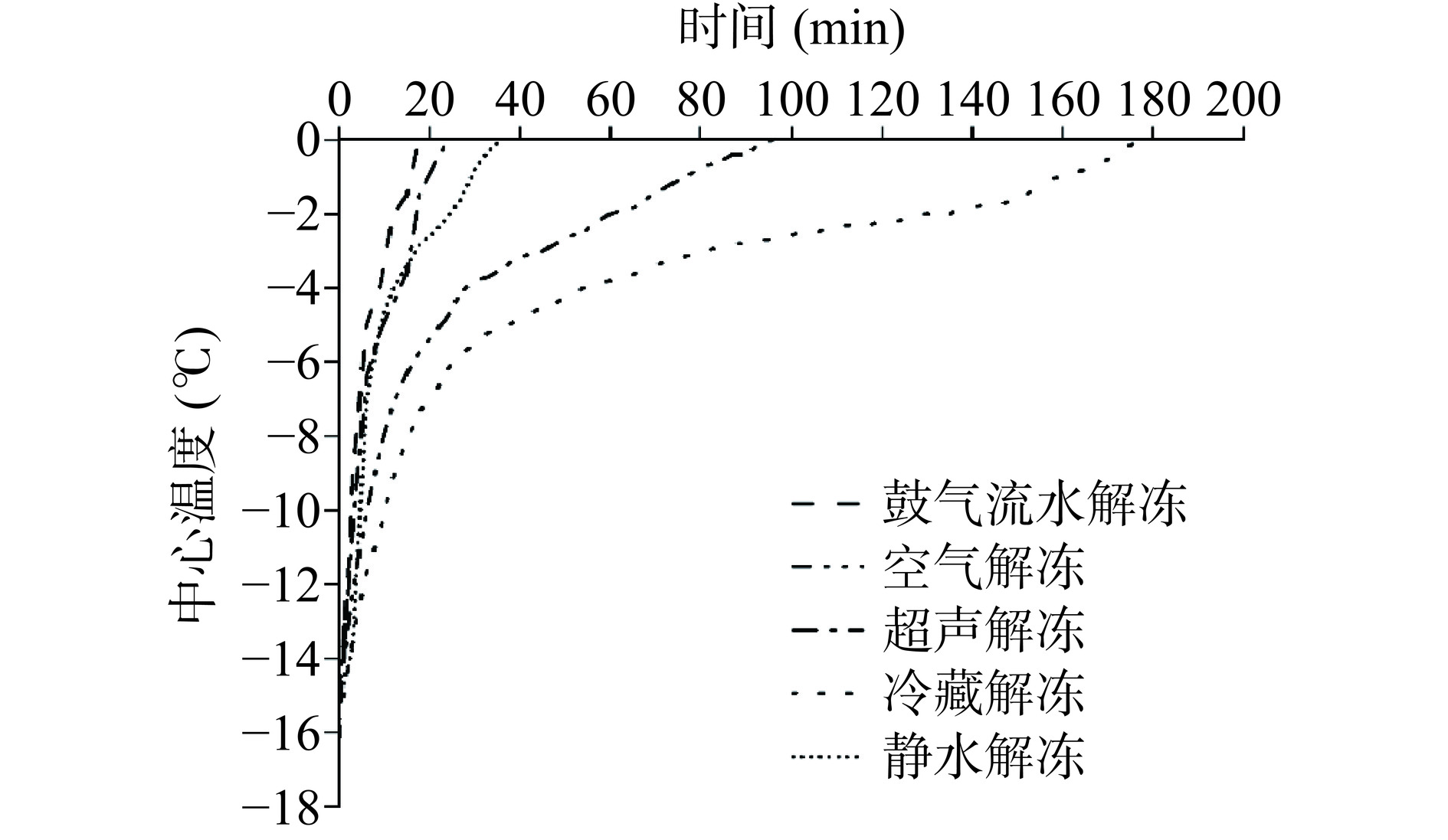
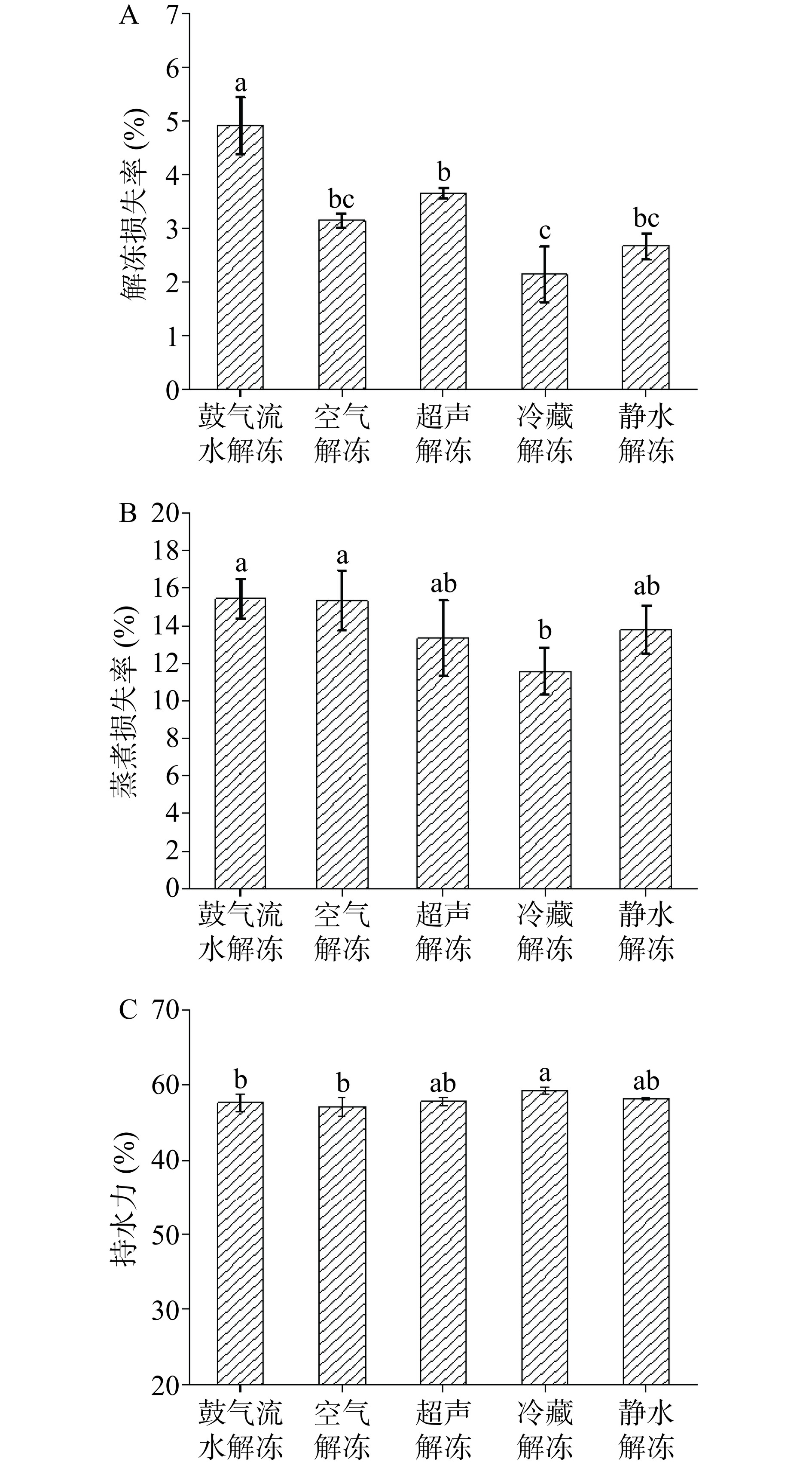
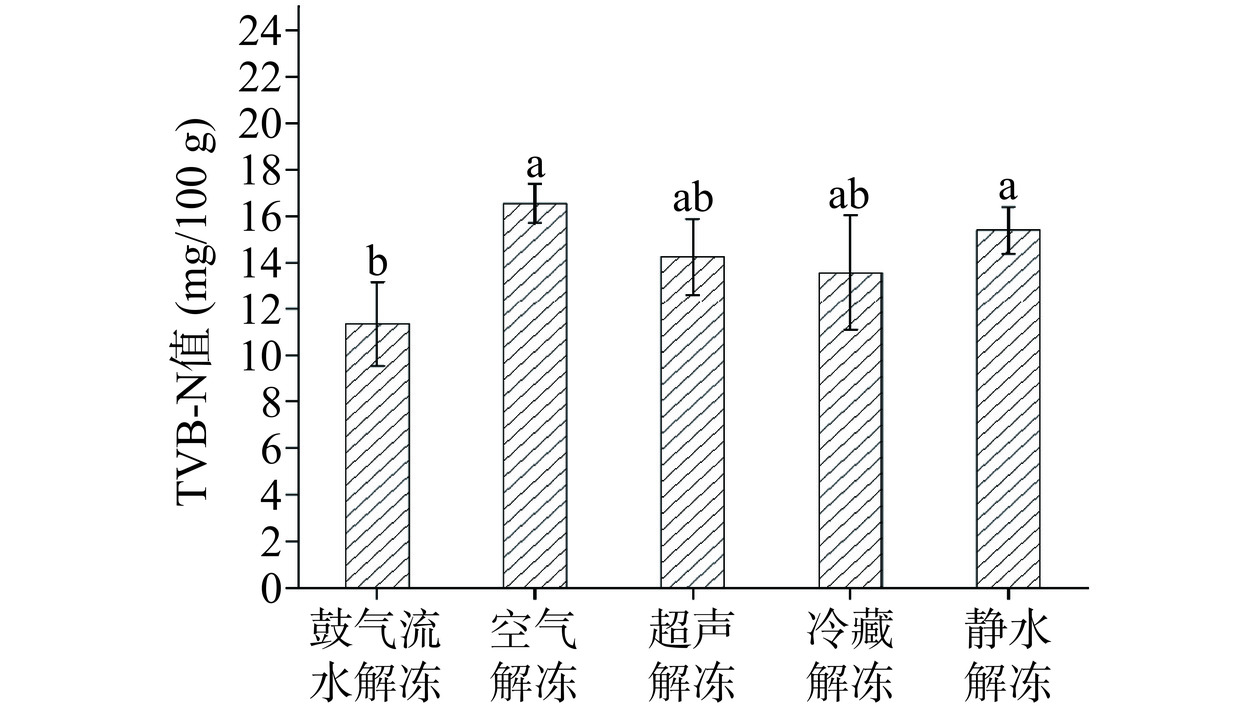
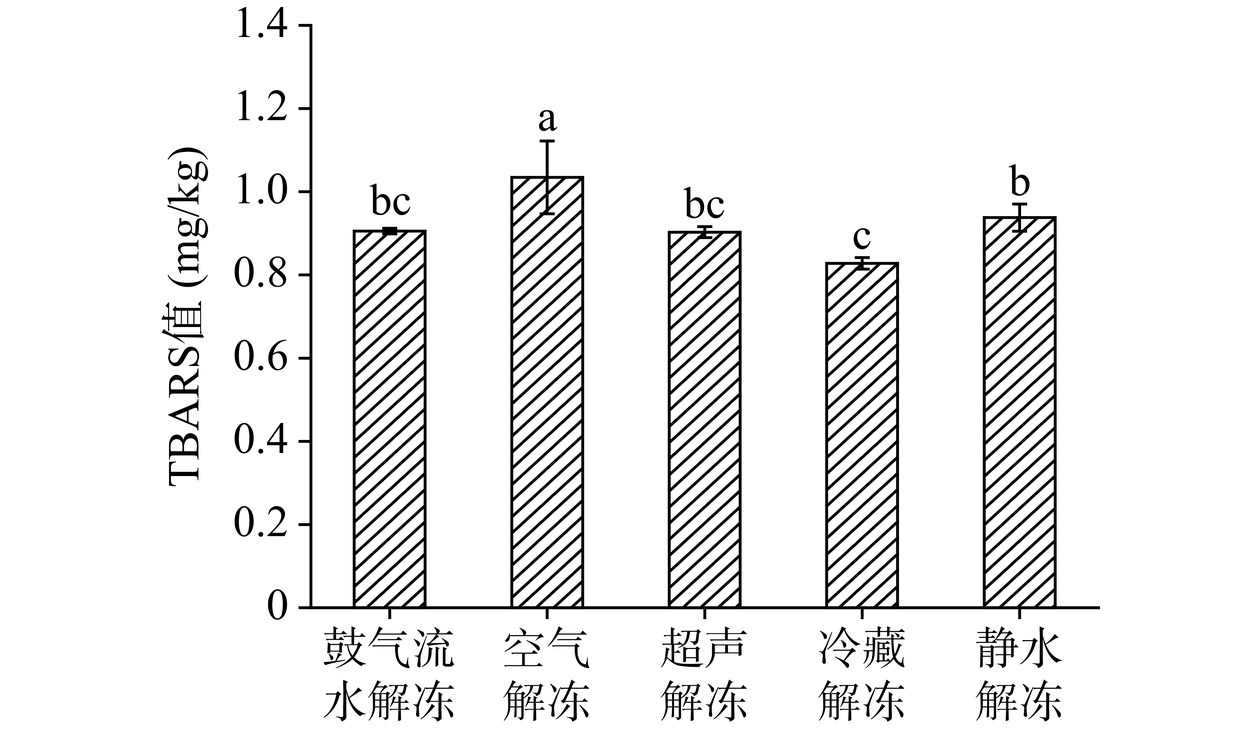
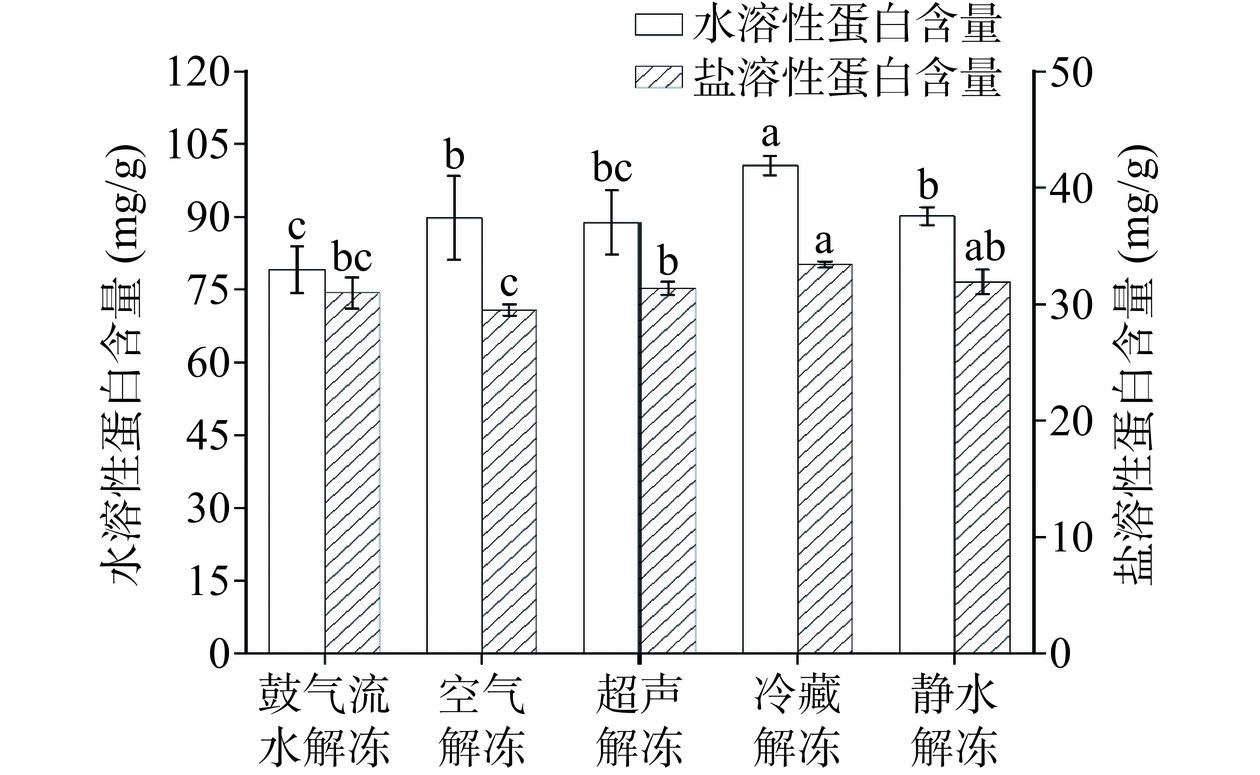
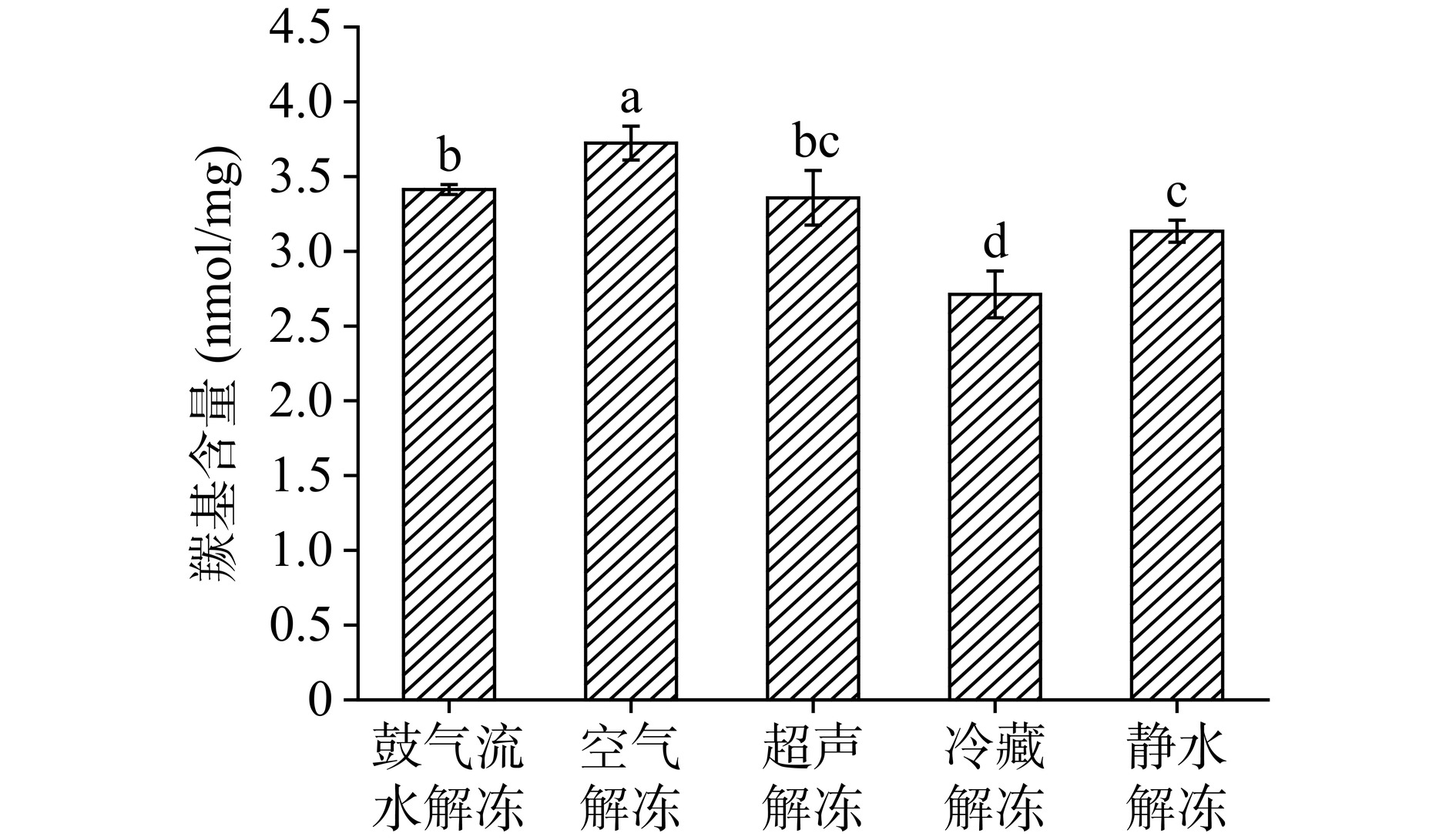
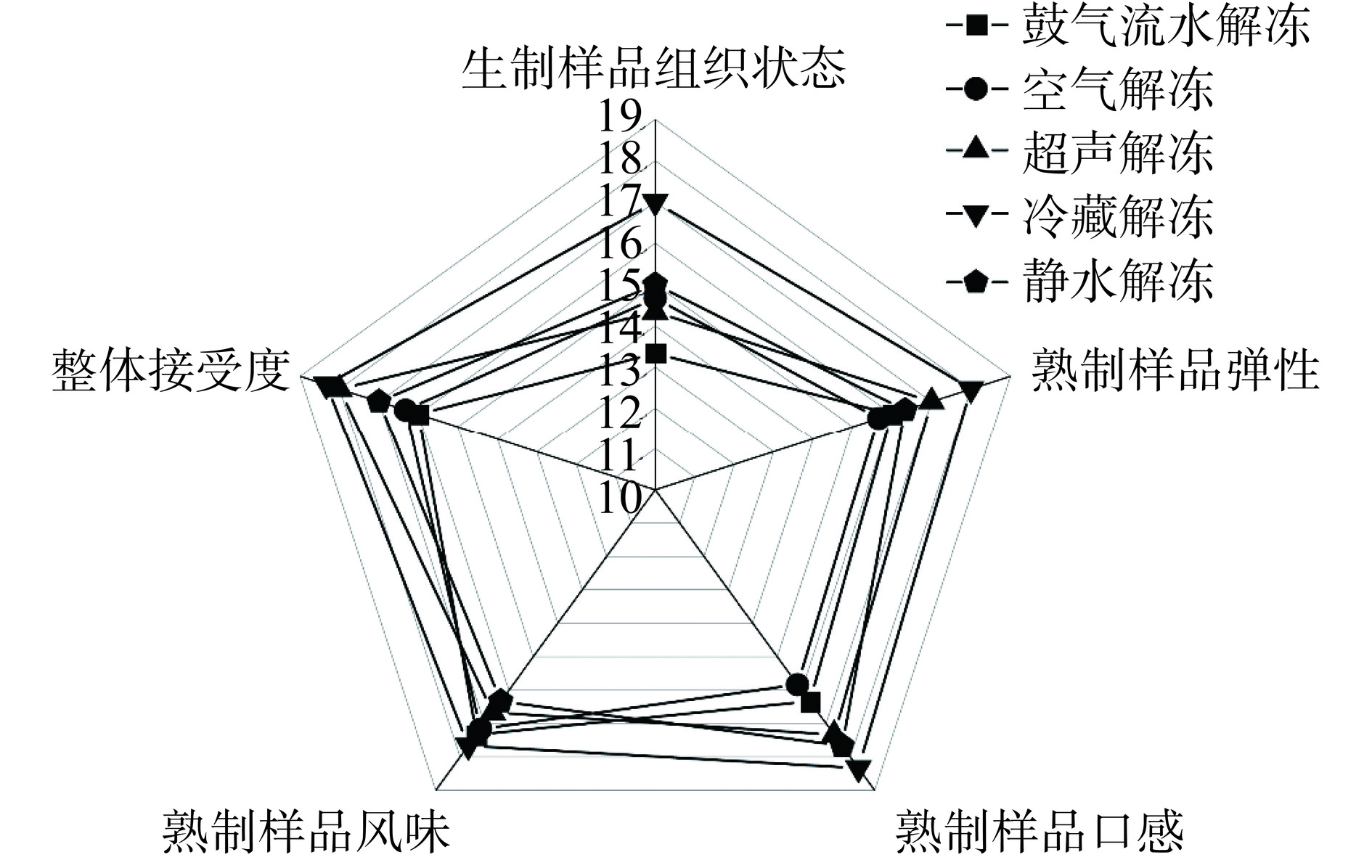
 下载:
下载:



